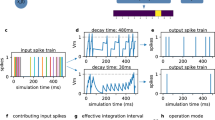Abstract
Fast Spiking GABAergic interneurons, also coupled through gap junctions too, receive excitatory synaptic inputs from pyramidal cells and a relevant problem is to understand how their outputs depend on the timing of their inputs. In recent experiments it was shown that Fast Spiking interneurons respond with high temporal precision to synaptic inputs and are very sensitive to their synchrony level. In this paper this topic is investigated theoretically by using biophysical modelling of a pair of coupled Fast Spiking interneurons. In particular it is shown that, in agreement with the experimental findings, Fast Spiking interneurons transmit presynaptic signals with high temporal precision. Moreover, they are capable of reading and transferring high frequency inputs while preserving their relative timing. Lastly, a pair of Fast Spiking interneurons, coupled by both inhibitory and electrical synapses, behaves as a coincidence detector.
Preview
Unable to display preview. Download preview PDF.
Similar content being viewed by others
References
Cobb, S.R., Buhl, E.H., Halasy, K., Paulsen, O., Somogyi, P.: Synchronization of neuronal activity in hippocampus by individual GABAergic interneurons. Nature 378, 75–78 (1995)
Pouille, F., Scanziani, M.: Enforcement of temporal fidelity in pyramidal cells by somatic feed-forward inhibition. Science 293, 1159–1163 (2001)
Galarreta, M., Hestrin, S.: Electrical synapses between GABA-releasing neurons. Nature Neurosci. 2, 425–433 (2001)
Galarreta, M., Hestrin, S.: Spike transmission and synchrony detection in networks of GABAergic interneurons. Science 292, 2295–2299 (2001)
Gibson, J.R., Michael Beierlein, M., Connors, B.W.: Functional Properties of Electrical Synapses Between Inhibitory Interneurons of Neocortical Layer 4. J. Neurophysiol. 93, 467–480 (2005)
Jonas, P., Bischofberger, J., Fricker, D., Miles, R.: Interneuron Diversity series: Fast in, fast out – temporal and spatial signal processing in hippocampal interneurons. TRENDS in Neurosciences 27, 30–40 (2004)
Whittington, M.A., Traub, R.D., Jefferys, J.G.: Synchronized oscillations in interneuron networks driven by metabotropic glutamate receptor activation. Nature 373, 612–615 (1995)
Wang, X.J., Buzsaki, G.: Gamma oscillation by synaptic inhibition in a hippocampal interneuronal network model. J. Neurosci. 16, 6402–6413 (1996)
Bartos, M., Vida, I., Frotscher, M., Meyer, A., Monyer, H., Geiger, J.R., Jonas, P.: Fast synaptic inhibition promotes synchronized gamma oscillations in hippocampal interneuron networks. PNAS 99, 13222–13227 (2002)
Lewis, T.J., Rinzel, J.: Dynamics of spiking neurons connected by both inhibitory and electrical coupling. J. Comput. Neurosci. 14, 283–309 (2003)
Bem, T., Rinzel, J.: Short Duty cycle destabilizes a half-center oscillator, but gap junctions can restabilize the anti-phase pattern. J. Neurophysiol. 91, 693–703 (2004)
Kopell, N., Ermentrout, B.: Chemical and electrical synapses perform complementary roles in the synchronization of interneuronal networks. PNAS 101, 15482–15487 (2004)
Pfeuty, B., Mato, G., Golomb, D., Hansel, D.: The Combined Effects of Inhibitory and Electrical Synapses in Synchrony. Neural Computation 17, 633–670 (2005)
Di Garbo, A., Panarese, A., Chillemi, S.: Gap junctions promote synchronous activities in a network of inhibitory interneurons. BioSystems 79, 91–99 (2005)
Erisir, A., Lau, D., Rudy, B., Leonard, C.S.: Function of specific K+ channels in sustained high-frequency firing of fast-spiking neocortical interneurons. J. Neurophysiology 82, 2476–2489 (1999)
Rinzel, J., Ermentrout, B.: Analysis of neural excitability and oscillations. In: Koch, Segev (eds.) Methods in neural modelling. The MIT Press, Cambridge (1989)
Galarreta, M., Hestrin, S.: Electrical and chemical Synapses among parvalbumin fast-spiking GABAergic interneurons in adult mouse neocortex. PNAS 99, 12438–12443 (2002)
Martina, M., Jonas, P.: Functional differences in Na+ channel gating between fast spiking interneurons and principal neurons of rat hippocampus. J. of Physiol. 505.3, 593–603 (1997)
Lien, C.C., Jonas, P.: Kv3 potassium conductance is necessary and kinetically optimized for high-frequency action potential generation in hippocampal interneurons. J. of Neurosci. 23, 2058–2068 (2003)
Rudolph, M., Destexhe, A.: The discharge variability of neocortical neurons during high-conductance states. Neuroscience 119, 855–873 (2003)
Singer, W.: Search for coherence: a basic principle of cortical self-organization. Concepts in Neurosci. 1, 1–26 (1990)
Gibson, J.R., Belerlein, M., Connors, B.W.: Two networks of electrically coupled inhibitory neurons in neocortex. Nature 402, 75–79 (1999)
Author information
Authors and Affiliations
Editor information
Editors and Affiliations
Rights and permissions
Copyright information
© 2005 Springer-Verlag Berlin Heidelberg
About this paper
Cite this paper
Di Garbo, A., Panarese, A., Barbi, M., Chillemi, S. (2005). Signal Transmission and Synchrony Detection in a Network of Inhibitory Interneurons. In: De Gregorio, M., Di Maio, V., Frucci, M., Musio, C. (eds) Brain, Vision, and Artificial Intelligence. BVAI 2005. Lecture Notes in Computer Science, vol 3704. Springer, Berlin, Heidelberg. https://doi.org/10.1007/11565123_5
Download citation
DOI: https://doi.org/10.1007/11565123_5
Publisher Name: Springer, Berlin, Heidelberg
Print ISBN: 978-3-540-29282-1
Online ISBN: 978-3-540-32029-6
eBook Packages: Computer ScienceComputer Science (R0)




